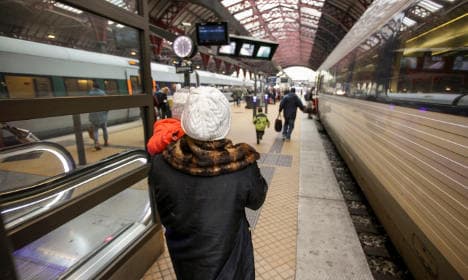Police stop dozens at Swedish border checks

UPDATED: Police continued to carry out ID checks on people crossing into Sweden on Friday, a day after border controls were reinstated to cope with an unprecedented influx of refugees.
Around 50 refugees and migrants were estimated to have headed back to Denmark since Sweden began checking cars, trains and ferries as part of its decision to introduce temporary border controls.
However, the exact number of people turned away at the borders on the Öresund Bridge and ferry terminals in southern Sweden remained unclear on Friday, with conflicting figures mentioned by officials.
"There have been around 50 people since 12pm [on Thursday] who did not wish to seek asylum. They were therefore sent back to Denmark," police spokesman Lars Förstell told Danish newspaper Berlingske.
Part of that number was made up of a group of at least 20 Iraqis who voluntarily agreed to go back to Denmark after by arriving in Sweden by train to Malmö or by ferry to Helsingborg.
“Somewhere between 20 and 30 people have chosen to voluntarily go back to Denmark when it was made clear to them it was not possible to transit through Sweden,” Patrik Engström, head of the police's border unit, told the TT newswire.
Meanwhile, the Migration Agency, which has previously warned it can no longer guarantee beds for everyone, said that it had not yet seen any indications that the border controls were keeping people away, saying around 1,600 refugees sought asylum in Sweden on Thursday.
"The number of people arriving is greater than the number of accommodation places opening up. We're working on an hour-by-hour basis. We have buses running north from Malmö where you sort out the housing along the way," said press spokesperson Fredrik Bengtsson.
But in Rostock, Germany, volunteers were seeing a drop in refugees seeking to board ferries to Sweden.
"Many don't have a passport and therefore they seek new routes to Sweden. Normally we have 300-400 people waiting for the ferry to Trelleborg, but right now there's no one here. Around 20 adults and children who are here today have decided to seek asylum in Germany," said volunteer Marcel who works at a refugee camp near Rostock.
READ ALSO: No, Sweden is not closing its borders
The decision to reinstate border checks is temporary and valid for 10 days, but can be renewed for up to six months under Schengen regulations on free movement.
Swedish police officials said on Thursday that they were preparing to have the controls in place for six months, though Sweden has made no such request yet.

The Öresund Bridge between Sweden and Denmark. Photo: Erland Vinberg/TT
The checks came after Sweden reinstated border controls on Thursday in a bid to gain control over a massive influx of migrants arriving in the country, without blocking a steady flow of asylum seekers.
People arriving in Sweden without valid identification documents will be allowed to seek asylum, but those who do not want to do so – for example those who simply want to transit through Sweden – will be refused entry.
"This is not a fence. We need to make sure that we have control (…) We have to make sure we know who is coming to Sweden," Prime Minister Stefan Löfven insisted.
Sweden, a country of 9.8 million people, has taken more refugees as a proportion of its population than any other country in Europe as the continent struggles with its biggest migration crisis since the Second World War.
The Scandinavian country expects to receive up to 190,000 asylum seekers this year – the equivalent of 1.5 million people arriving in a country the size of Germany, and more than double the 80,000 it took in last year.
Comments
See Also
Around 50 refugees and migrants were estimated to have headed back to Denmark since Sweden began checking cars, trains and ferries as part of its decision to introduce temporary border controls.
However, the exact number of people turned away at the borders on the Öresund Bridge and ferry terminals in southern Sweden remained unclear on Friday, with conflicting figures mentioned by officials.
"There have been around 50 people since 12pm [on Thursday] who did not wish to seek asylum. They were therefore sent back to Denmark," police spokesman Lars Förstell told Danish newspaper Berlingske.
“Somewhere between 20 and 30 people have chosen to voluntarily go back to Denmark when it was made clear to them it was not possible to transit through Sweden,” Patrik Engström, head of the police's border unit, told the TT newswire.
Meanwhile, the Migration Agency, which has previously warned it can no longer guarantee beds for everyone, said that it had not yet seen any indications that the border controls were keeping people away, saying around 1,600 refugees sought asylum in Sweden on Thursday.
"The number of people arriving is greater than the number of accommodation places opening up. We're working on an hour-by-hour basis. We have buses running north from Malmö where you sort out the housing along the way," said press spokesperson Fredrik Bengtsson.
But in Rostock, Germany, volunteers were seeing a drop in refugees seeking to board ferries to Sweden.
"Many don't have a passport and therefore they seek new routes to Sweden. Normally we have 300-400 people waiting for the ferry to Trelleborg, but right now there's no one here. Around 20 adults and children who are here today have decided to seek asylum in Germany," said volunteer Marcel who works at a refugee camp near Rostock.
READ ALSO: No, Sweden is not closing its borders
The decision to reinstate border checks is temporary and valid for 10 days, but can be renewed for up to six months under Schengen regulations on free movement.
Swedish police officials said on Thursday that they were preparing to have the controls in place for six months, though Sweden has made no such request yet.

The Öresund Bridge between Sweden and Denmark. Photo: Erland Vinberg/TT
The checks came after Sweden reinstated border controls on Thursday in a bid to gain control over a massive influx of migrants arriving in the country, without blocking a steady flow of asylum seekers.
People arriving in Sweden without valid identification documents will be allowed to seek asylum, but those who do not want to do so – for example those who simply want to transit through Sweden – will be refused entry.
"This is not a fence. We need to make sure that we have control (…) We have to make sure we know who is coming to Sweden," Prime Minister Stefan Löfven insisted.
Sweden, a country of 9.8 million people, has taken more refugees as a proportion of its population than any other country in Europe as the continent struggles with its biggest migration crisis since the Second World War.
The Scandinavian country expects to receive up to 190,000 asylum seekers this year – the equivalent of 1.5 million people arriving in a country the size of Germany, and more than double the 80,000 it took in last year.
Join the conversation in our comments section below. Share your own views and experience and if you have a question or suggestion for our journalists then email us at [email protected].
Please keep comments civil, constructive and on topic – and make sure to read our terms of use before getting involved.
Please log in here to leave a comment.